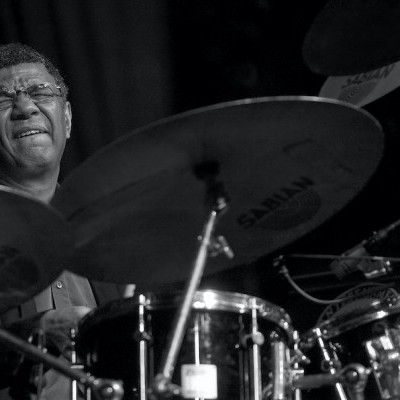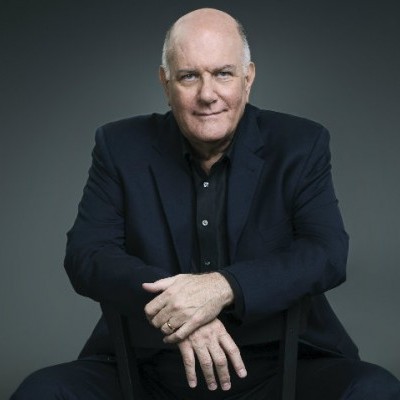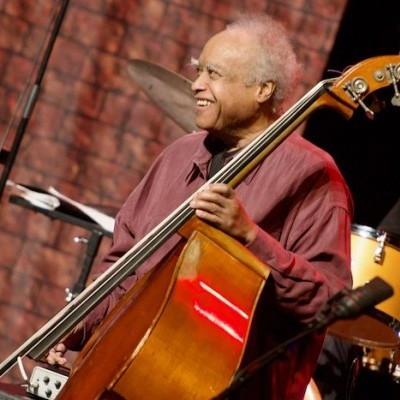Oct 28, 2025 10:47 AM
In Memoriam: Jack DeJohnette, 1942–2025
Jack DeJohnette, a bold and resourceful drummer and NEA Jazz Master who forged a unique vocabulary on the kit over his…

“No matter how complex the source is, I still ask myself a question: Does it feel good?” says Brennan.
(Photo: Werner Siebert)You could pretty much see this one coming. If you were one of Patricia Brennan’s Facebook friends, her wall posts around the end of 2024 seemed like a full-blown gratitude festival. The bandleader’s thank-yous to publications praising Breaking Stretch (for either album-of-the-year status or one of the annum’s top 10) stacked up with increased velocity, each new citation heaping more love on the vibraphonist’s work.
The New York Times, Bandcamp, NPR, the Francis Davis Jazz Critics Poll, Stereogum, Pop Matters, NYC Jazz Record, even Kareem Abdul- Jabbar threw compliments her way. From its Sept. 6 arrival date to the end of December and beyond, the buzz was undeniable. A consensus album.
And why not? Brennan’s third disc, a septet affair based around reeds, brass and rhythm, was intrepid and visionary, the subject of several glowing conversations in my neck of the woods. Now the DownBeat Critics Poll makes it the year’s top dog, and, yeah, you could pretty much see it coming. It’s extra-sweet that our writers have also deemed Brennan Vibraphonist of the Year, a hard-earned distinction in an era when the instrument has several impressive players.
The 40-year-old mallet whiz is fully tickled by the acclaim, but during a recent video chat quickly yields to the collective prowess of the squad who so effectively rendered her quite elaborate, rather tricky and occasionally daunting pieces.
“The whole team made it what it is,” Brennan says. “[The most] satisfying part is knowing that what I wanted the listener to feel and hear actually came through. It’s about communication. As a composer, as a performer, the fact that the message got across is awesome.”
That team is populated by some of modern jazz’s most impressive improvisers. Trumpeter Adam O’Farrill and saxophonists Jon Irabagon and Mark Shim unite with the remarkably insistent rhythm section of drummer Marcus Gilmore, bassist Kim Cass, percussionist Mauricio Herrera and the leader on marimba, vibraphone and electronics. And that message — well, it can be complex at times.
This critic gave the record a full five stars in DownBeat’s November issue, and the review applauded the storm of action responsible for the music’s character.
Swirling thematic motifs, frenzied sax declarations, time-signature disruptions, Soca allusions, bass reveries, abstract brasstronica, heartrending pastorals … all seem to be unleashed at once.
Breaking Stretch (Pyroclastic) isn’t mainstream fare, but the eloquence of its commotion is obvious. A big dash of pleasure comes from the roiling intricacies of its astutely calibrated thrust. “Five Suns” is a futuristic “Salt Peanuts,” thick with zig-zagging motifs. “Manufacturers Trust Company Building” is three-and-a-half minutes of jagged outbursts, orchestrated to shift while activating new ways to dazzle the listener.
Many of these pieces start with the rhythmic structures pointedly scripted by the composer; this child of the conservatory is now an educator as well, and Brennan says she often has a “very mathematical” way of shaping her music, as on the album’s “555,” which breaks down the time combinations to create a clave web that instantly sucks you in. Shim blows blustery over the loping jaunt, and the other horns circle the track’s upper atmosphere like hawks on the hunt. Brennan’s instrument is in the foreground, nudging Cass’ pulse and the drummers’ poly-beats. “It’s everyone’s job to make the music move,” she confides.
This swarm of sounds is something the Mexico-born, Brooklyn-based Brennan was looking for while writing and recording. At times the group sounds larger than seven instruments, and that too was sketched out. A vitality that any bandleader would love to claim lives within the charts’ cross-hatched lines. But, she cautions, density isn’t a goal in and of itself; the performance must always be seducing the listener on some level.
“No matter how complex the source is, I still ask myself a question: Does it feel good? I could add all these crazy rhythms, but if it doesn’t make any sense, and I’m just doing it for the sake of making it complicated, it misses its purpose.”
That outlook is born of a music-drenched upbringing. Brennan was raised in a home full of songs with a percussionist father and a Zep- and Hendrix-loving mom. Outside, the street musicians of Veracruz were ubiquitous. “Even if you want to get away from them, they follow you. No joke, you’ll literally see four guys outside a restaurant carrying a marimba everywhere.”
She grew up playing piano and percussion as a child. By 15, she was studying harmony, counterpoint and more advanced compositional mechanics. Balancing street sounds with classical notions is part of her agenda. She says she never particularly saw them as two separate things. When the conversation turns to that stance being a way of disrupting musical stereotypes, the subject of rebellion bubbles up.
“I’m basically cautious and need to do lots of pre-planning, but I’ve always questioned things. It’s not that I was disobedient or anything, but I’ve often thought, ‘Why is it [done] this way?’ So maybe a rebel spirit comes into it.”
Veteran producer David Breskin, who has helmed several titles for Pyroclastic, helped organize many of these notions. He was behind the board for Brennan’s second disc, More Touch, and established a simpatico bond with the bandleader that bolstered the impact of Breaking Stretch. Focusing on precision and punch, Breskin wanted to make “each ingredient be distinct without separating them so much that it feels sterile. I like it when all the instruments are kind of glued together,” he says.
Another compelling facet is track flow; Breaking Stretch scans as if it were a planned-out suite. Breskin, who is an insightful writer in a variety of realms and has produced artists as diverse as Ronald Shannon Jackson and Mary Halvorson, has a strong grip on ways to make a program engagingly unfold.
“I don’t know that much about music [in specific],” he says with a sly grin, “but what I do know — and I think this goes to my background as both a journalist and poet — is how to tell a story. ‘How do [these pieces] link together? And how can we end up somewhere different than where we started?’ I’m trying to build a fabric.”
Mission accomplished, because another key attribute of Breaking Stretch is the coherence of its emotional arc. Once it starts, each song seems to be passing the baton to the next; the album refuses to yield until it’s had its full say.
“I remember sending [David] two different sequence options and he definitely [weighed in], because he thinks about the same things,” says Brennan. “And you mentioned clarity before; on this album he pushed me to explore the limits, but was always reminding us to remember the listener. To have someone corroborating your actions … makes you even more motivated.”
Together with accumulated experience, such support has nudged the vibraphonist into becoming a more seasoned leader, a captain who wants to make sure “everybody’s taken care of, and nobody’s feeling the stress of any situation.”
That jibes with Irabagon’s perspective. He was pleased to have a few days of rehearsal and plenty of studio time to record. “It’s rare that you get an opportunity to really dig into music like that,” he says. “She had, what, 10 or 11 tunes with amazing melody lines and crazy rhythmic things? Every aspect of it was challenging and beautiful at the same time. [We all left] the studio saying, ‘Man, this is probably going to be one of the best records I’m ever going to be on.’ And now it’s one of those rare cases where the album is getting the recognition it deserves.”
The saxophonist was also impressed by his boss’s improvising skills, deeming her “a great vibraphonist.” The DownBeat voters concur, and Brennan, a Bobby Hutcherson fiend who genuflects to Walt Dickerson and Steve Nelson, remains enthralled with her instrument and its possibilities. “The vibraphone is still new in so many ways,” she says. “Its sound quality is so mysterious and so weird at the same time. It’s transparent, but it’s clean; it’s loud, but it’s soft.”
Brennan augments her approach with electronics. At an intimate gig with O’Farrill at Brooklyn’s Lowlands earlier this year, she seemed to be glancing at her foot pedals as much as she was at the bars.
“The [pedals] are just another color in my palette; they expand the instrument’s range beyond what’s there acoustically. It’s silly to limit any options.”
Brennan’s experimental streak drives Of The Near And Far, her next album due in October. It’s a sextet augmented by a string ensemble that claims Stravinsky, Stockhausen and Soundgarden as influences.
Intrigued by astrophotography, Brennan writes that ideas for the new music came from pondering what lies beyond the night sky, and turns the “shapes of the constellations into pitch collections.” Who knows? Maybe the superunknown is best divined with mallets. DB

Jack DeJohnette boasted a musical resume that was as long as it was fearsome.
Oct 28, 2025 10:47 AM
Jack DeJohnette, a bold and resourceful drummer and NEA Jazz Master who forged a unique vocabulary on the kit over his…

D’Angelo achieved commercial and critical success experimenting with a fusion of jazz, funk, soul, R&B and hip-hop.
Oct 14, 2025 1:47 PM
D’Angelo, a Grammy-winning R&B and neo-soul singer, guitarist and pianist who exerted a profound influence on 21st…

Kandace Springs channeled Shirley Horn’s deliberate phrasing and sublime self-accompaniment during her set at this year’s Pittsburgh International Jazz Festival.
Sep 30, 2025 12:28 PM
Janis Burley, the Pittsburgh International Jazz Festival’s founder and artistic director, did not, as might be…

Jim McNeely’s singular body of work had a profound and lasting influence on many of today’s top jazz composers in the U.S. and in Europe.
Oct 7, 2025 3:40 PM
Pianist Jim McNeely, one of the most distinguished large ensemble jazz composers of his generation, died Sept. 26 at…

Drummond was cherished by generations of mainstream jazz listeners and bandleaders for his authoritative tonal presence, a defining quality of his style most apparent when he played his instrument unamplified.
Nov 4, 2025 11:39 AM
Ray Drummond, a first-call bassist who appeared on hundreds of albums as a sideman for some of the top names in jazz…